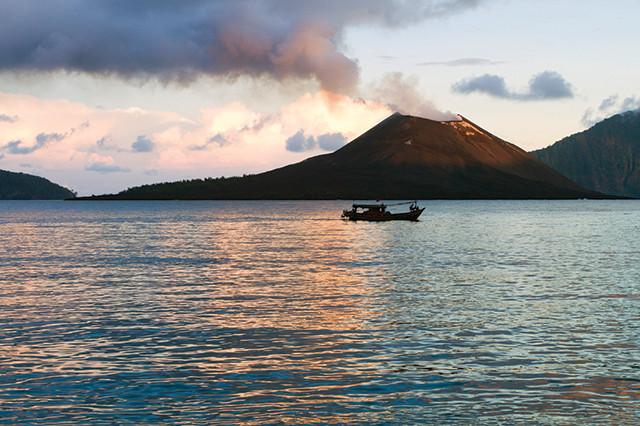
by Michael E. Webber and Sheril R. Kirshenbaum Thursday, March 3, 2016

Krakatau volcano in Indonesia. Credit: iStock.com/Oystein Lund Andersen
Just over two hundred years ago, on the Indonesian island of Sumbawa, Mount Tambora erupted with an explosive plume that ejected debris up to 43 kilometers into the atmosphere, darkening daytime skies. Molten rock and pyroclastic flows cascaded down the volcano’s flanks as ash spread out over hundreds of thousands of square kilometers. This was the most powerful volcanic eruption of the past 500 years. Tsunamis surged. Tens of thousands of people died directly from the eruption, with hundreds of thousands more dying in its aftermath from the starvation and disease that followed widespread crop failures.
Scientists have documented how this event triggered global cooling: When sulfur released from the volcano reached the stratosphere, it spread around the equator and toward the poles. Once oxidized, tiny reflective particles limited the amount of sunlight reaching Earth’s surface and the entire planet got colder. Average temperatures temporarily dropped approximately one degree Fahrenheit. As a result, 1816 became known as “The Year Without a Summer.”
The apocalyptic conditions subsided after about three years, but this incidence of temporary naturally occurring climate change left a surprising and persistent cultural impact, which has influenced our current reticence to deal with anthropogenic climate change.
During the unusually dark and stormy summer months of 1816, British teenager Mary Wollstonecraft Godwin (soon to be known as Mary Shelley) and her poet friends, including Lord Byron, were forced to stay inside their chalet at Lake Geneva to avoid perpetual rain. To pass the time, they read ghost stories and eventually agreed to try writing their own. This spurred Shelley to compose her now-classic masterpiece “Frankenstein.” The story gripped the public’s imagination, but also unintentionally shaped their fears of science, fostering distrust of scientists and the scientific method.
Hollywood’s 1931 adaptation of Shelley’s book seemed much like a treatise against science. The film focused on the theme of scientists trying to play God, which led to catastrophic consequences. The monster that scientist Dr. Frankenstein unleashed on society left a lasting impact. Famed science writer Stephen Jay Gould lamented the influence of “Frankenstein” on popular culture, noting how subsequent movies have reinforced the idea that scientists like to play God and put society at risk, and so should not be trusted. “The China Syndrome,” “12 Monkeys,” “Austin Powers,” “Spiderman” and “Jurassic Park” are among other films in recent decades that have further reinforced this theme. There are many, many more.
Unfortunately, the cumulative impact of films like these coupled with politically motivated misinformation campaigns about science has become a barrier to using science to inform public policymaking and has fostered a widespread suspicion of the scientific community. This mistrust plays out in a variety of ways, from frequent accusations of scientific arrogance to complete dismissal of climate change altogether.
So in a surprising turn of circumstances, naturally occurring climate change — from a volcano — spurred an imaginative story that, in turn, made society wary of scientists. Two centuries later, man-made climate change — from the combustion of fossil fuels, agriculture and land-use changes — has made our world increasingly vulnerable to flooding, extreme weather events, drought and instability. Unfortunately, deep-rooted skepticism toward science and scientists persists, largely along political lines and over certain issues, which means scientists’ dire warnings about climate impacts go unheeded. As a result, we are slow to act on one of the gravest risks to modern civilization.
Now, as we need our scientists the most, they are trusted the least — at least when it comes to climate change. It is time for us to get over our skepticism and lean on the science community for fact-based insights on the world around us, without interference from political interests, agenda-driven PR campaigns, or from dramatic license on screen or in print. If we do this the right way, then we can avoid a repeat of the dire consequences the Mount Tambora eruption kicked off — only all the more magnified this time around.
Unlike the sulfur particles emitted by Tambora, the causes of man-made climate change are not going to dissipate — nor will their impacts abate — in a matter of a few years.
If we act fast, it won’t be too late.
© 2008-2021. All rights reserved. Any copying, redistribution or retransmission of any of the contents of this service without the expressed written permission of the American Geosciences Institute is expressly prohibited. Click here for all copyright requests.